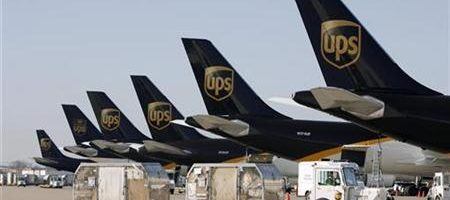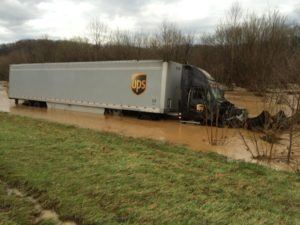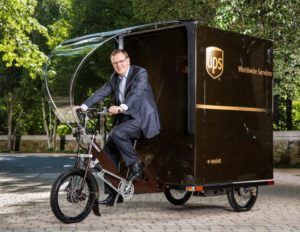Uncontrollable Pollution Source?

UPS is one of the largest contributors of greenhouse gas emissions in the transportation sector, and one of the companies likely to see its operations affected the most by the effects of climate change. What is it doing? Is it enough?
UPS is the world’s largest package delivery provider[1]. The operation has a scale beyond imagination: it delivered 4.7 billion packages in 2015 alone. It has a dedicated air-cargo fleet that covers almost 2000 daily flights, a ground delivery fleet of 110,000 vehicles, and it is present in 220 countries[2].
It is widely known that the transportation & logistics sector is a major source of global pollution, accounting for about 14% of all anthropogenic greenhouse gas (GHG) emissions[3]. What is probably not widely known, however, is that UPS has the 2nd largest GHG footprint sector[4].
The perfect storm
Climate change poses a major threat to UPS. The biggest one is the reduction of net income that the company faces in the wake of existing and potential regulation. Taxes, or other schemes to disincentivize use of fossil fuels, will result in increased prices of this resource.[5] Moreover, regulation is also in the works to reduce operating emissions of logistic companies both in the US[6], and internationally[7]. This will result in higher delivery costs, which will translate to higher prices and lower demand for services.
A second, and less obvious threat, is the impact of warmer weather. Higher temperatures affect the  operational performance of the air-fleet, since aircraft payload is reduced with higher temperatures. Moreover, warm weather can result in the buckling of roads, railways and bridges – infrastructure critical for delivery operations.[8] Last, droughts will also increase, resulting in a higher price of the biofuels on which the company is partly relying on to offset its GHG footprint.
operational performance of the air-fleet, since aircraft payload is reduced with higher temperatures. Moreover, warm weather can result in the buckling of roads, railways and bridges – infrastructure critical for delivery operations.[8] Last, droughts will also increase, resulting in a higher price of the biofuels on which the company is partly relying on to offset its GHG footprint.
And it’s not just temperature. The increase in violent weather phenomena poses a major operational threat (and cost) to the company. Storms may prevent aircraft from operating, potentially forcing a temporary shutdown of a major distribution center, with disruption cascading across all the value chain. Also, sea-level rise and flooding may result in road closures and inaccessibility of cities, delaying deliveries or even rendering them impossible, while also damaging infrastructure and vehicles.[9] [10]
An umbrella, at least
Sustainability appears to be a core issue on UPS’s agenda, as evidenced by its sustainability governance. The company has an overall plan to reduce carbon emissions 20% by 2020 vs its 2007 baseline, and it had already achieved 14.5% as of 2015. There are two main areas on which the company is working to achieve this goal.
 First, is increased fleet efficiency. The company is rolling out ground vehicles that make use of alternative energy. The spectrum is wide, and includes trucks that use LNG or renewable diesel, hybrids, and purely electric vehicles[11]. An interesting example is the electrically-assisted tricycle being tried out in Hamburg[12] (see left). Additionally, the company is working to improve the fuel efficiency of its aircraft. Efforts include retrofits to the current fleet, such as the installation of winglets, and the incorporation of new, more fuel-efficient aircraft. Just this week, the company announced an order for 14 Boeing 747-800’s which is 16% more fuel efficient than the previous version.[13] [14] UPS is also venturing further into technology, trialing Drone Deliveries.
First, is increased fleet efficiency. The company is rolling out ground vehicles that make use of alternative energy. The spectrum is wide, and includes trucks that use LNG or renewable diesel, hybrids, and purely electric vehicles[11]. An interesting example is the electrically-assisted tricycle being tried out in Hamburg[12] (see left). Additionally, the company is working to improve the fuel efficiency of its aircraft. Efforts include retrofits to the current fleet, such as the installation of winglets, and the incorporation of new, more fuel-efficient aircraft. Just this week, the company announced an order for 14 Boeing 747-800’s which is 16% more fuel efficient than the previous version.[13] [14] UPS is also venturing further into technology, trialing Drone Deliveries.
Second, the company is improving its operating efficiency, reducing the number of vehicle-miles required to deliver a package. Chief amongst the initiatives is “Orion”, a proprietary software that optimizes route design for trucks, and will reduce 100 million truck-miles annually. The efforts are not limited to the ground – more accurate flight planning is allowing more direct flight paths and lower separation between aircraft, both of which result in fuel savings.
But… is it enough?
While the company’s efforts are commendable, there is room for improvement. The company’s goal seems small when compared for example with the EU’s goals of 40% reduction vs 1990 baseline by 2030[15]. There are many efforts that the company is leaving off  the table, like the use of alternative fuels in aviation, which it has not yet done mainly due to concerns of availability and price.
the table, like the use of alternative fuels in aviation, which it has not yet done mainly due to concerns of availability and price.
On a bigger scheme, all attempts described before are incremental, when the world needs step changes. A leader like UPS should make a stronger attempt to leverage new technologies to drive that change. For example, why not increase drone delivery tests? Why not invest to develop solar-powered planes for transportation?
But wait… it’s not just UPS. You and I can also make a difference! UPS claims that next-day deliveries have a higher GHG footprint because they are less efficient. Maybe the next time you place an order you can choose for 5-day ground, help the environment, and save a few dollars… they’ll come in handy next year!
Word Count (752)
[1] United Parcel Service, 2015 Corporate Sustainability Report (Atlanta, GA: UPS, 2015) p. 8.
[2] United Parcel Service, 2015 Annual Report (Atlanta, GA: UPS, 2015) p. 1.
[3] International Panel on Climate Change, Climate Change 2014 Synthesis Report (Geneva, Switzerland: IPCC, 2014) p. 47.
[4] John Moorhead, Tim Nixon, Global 500 Greenhouse Gases Performance 2010-2015 – 2016 Report on Trends, Thomson Reuters White Paper, 2016, p. 10.
[5] United Nations Environmental Programme, GEO-5 for Business – Impacts of a Changing Environment on the Corporate Sector, (Nairobi, Kenya: UNEP, 2013) p. 42.
[6] Jad Mouawad, Coral Davenport, E.P.A. Takes Step to Cut Emissions From Planes, New York Times, June 10, 2015 [http://www.nytimes.com/2015/06/11/business/energy-environment/epa-says-it-will-set-rules-for-airplane-emissions.html?_r=0], accessed November 2, 2016.
[7] M.R., Airlines are to cough-up for cross border flight pollution, The Economist, October 10, 2016 [http://www.economist.com/blogs/gulliver/2016/10/clearing-air], accessed November 1, 2016.
[8] D. Jaroszweski et al, Assessing the potential impact of climate change on transportation: the need for an interdisciplinary approach, Journal of Transport Geography 18 (2010) 331–335, via Google Scholar, accessed October 31, 2016.
[9] M.J. Koetse, P. Rietveld, The impact of climate change and weather on transport: An overview of empirical findings, Transportation Research Part D 14 (2009) p. 205–221, via Google Scholar, accessed October 31, 2016.
[10] G. Lovea et al, Climate Change, Climate Variability and Transportation, Procedia Environmental Sciences 1 (2010) 130–145, via Google Scholar, accessed October 31, 2016.
[11] Cathy Proctor, Loveland’s cleantech Lightning Hybrids on a roll with orders from UPS, others, Denver Business Journal, October 31, 2016, via Factiva, accessed on October 31, 2016.
[12] Joann Muller, UPS Is Conducting A Vast Rolling Lab Experiment To Create The Clean Truck Of The Future, Forbes.com, September 30, 2016 [http://www.forbes.com/sites/joannmuller/2016/09/30/ups-employs-vast-rolling-laboratory-to-discover-clean-truck-of-the-future/#1b0a6a3a1f31], accessed November 2, 2016
[13] Linda Blachly, UPS orders up to 28 Boeing 747-8 freighters, Air Transport World, October 31, 2016, via Google Scholar, accessed October 31, 2016.
[14] Boeing Company Website, http://www.boeing.com/commercial/747/#/design-highlights/economy-performance/profitability/lower-fuel-cost/, accessed October 31, 2016.
[15] European Comission Climate Action Website, http://ec.europa.eu/clima/policies/strategies/2030/index_en.htm, accessed November 1, 2016.



Great post, Josue! Has UPS looked into potentially reducing both costs and emissions by making sure that trucks, flights, etc. are full? Having non-full delivery vehicles can easily increase GHG emissions as more vehicles are needed to make the same amount of deliveries. The clear pushback to this idea would be that waiting until full-loads might decrease the speed of delivery. As such, I wonder if there is some way UPS can determine the cost-benefit to price packages so that most people would choose the full-truck option.
Hi Kelly, thanks for your comment! As a matter of fact, UPS has done some effort to improve efficiency on both fronts (see below). The effort is more evident in trucks. I fully agree with you that a revamped pricing strategy could be used to decrease the appetite for next day delivery, but UPS runs the risk of having those customers switch to the competition instead of opting for a longer delivery time-frame. Like we discussed today in Ikea, this is the tension between business and sustainability. So far UPS appears to have opted for business (as most others).
******
In terms of trucks, UPS’s Sustainability Report states that they recently acquired a logistics company in the US (Coyote) which is highly complementary to the existing business, because it helps to fill trucks during re-positioning stages. Basically, trucks leave distribution centers full of packages to deliver, but usually return empty. Coyote’s volume is used to fill the trucks on the return stage, thus improving utilization.
In terms of flights, it has usually been the goal of logistics operators to operate flights with as high a payload as possible. There are many ways cargo airlines put this practice. One curious example is circular scheduling. Goods don’t fly round-trip like passengers. Imagine that you have certain goods that need to get from point A to point B (eg: flowers from Netherlands to New York), but there’s nothing flowing from point B to point A. Then to make flying more efficient, instead of flying an empty plane from B to A, you find a third point C to which point B is sending goods. This might be, for example, medication from New York to China. You then close the loop by sending electronics from China to the Netherlands. In the case of UPS this type of scheduling is not as evident as in “full” cargo airlines, since UPS has a significant courier business (small packages) which tends to have a higher bi-directional flow. This results in more out and back flying, which is less efficient if you do not have enough volume to justify it. In fact, UPS admits that the need to make many next-day deliveries results in having daily flight schedules on routes where airplanes might not fly at full capacity.
Great post! Package delivery service providers are indeed one of the largest contributors to global warming – and therefore have the most potential to drive significant change in their business. From transportation costs to packaging sizes and usage of recycled materials, I can think of few businesses that affect the environment that much.
I agree to the claim that UPS is moving in the right direction – but it does not do enough. Increasing customer awareness about how their behavior using UPS’s services affect the environment does not seem to be one of the company’s main priorities. This is especially evident when observing the UPS Next Day Air service on UPS’s official website (https://www.ups.com). While all benefits of next day service are clearly presented, the fact that those create a higher GHG footprint is nowhere to be found, and there are no significant pricing incentives to move away from this option.
Educating customers will reduce emissions but decrease profitability, and it seems UPS is just not willing to fully commit to this move.
To Aviad’s point about how to influence consumer behavior and encourage them to use more eco-friendly delivery methods, maybe UPS could institute an ‘environmental charge’, or something similar as a separate line-item. There may be an equilibrium point where consumers are dissuaded from unnecessarily using high GHG methods, but UPS’s profit margins aren’t hit. I’m not sure how this could be implemented in reality.
Thanks for this post!
I do wonder whether UPS will really have to face up to the impact of climate change on their business, or whether in fact development of 3D printing will be a bigger concern for them, or even potentially their downfall, long before taxes and temperature take their toll in a meaningful way.
Right now it seems inconceivable that people would stop sending packages through a service like UPS, but just as email has challenged snail mail, I wouldn’t be surprised if in 20 years, the demand for UPS’ services had shrunk dramatically, with people printing all their online purchases at home on a 3-D printer. This trend isn’t even exclusive to new purchases – I printed a key off a kiosk in New York last week off from a photograph taken in Chicago. As this technology proliferates, surely the need to send items through the mail will decrease?
What’s interesting is that if that’s true, UPS might actually worry less about sustainability from a climate perspective and more from the perspective of the viability of their product long term. However, it’s all guesswork right now – so they cannot afford to neglect the climate question entirely.
Very interesting blog Josue. I agree that the reduction targets are fairly moderate and disappointing for a company with a large carbon footprint like UPS. Your point around one-day shipping is fascinating as well. I wonder if there is an agreement to be made with websites like Amazon to better indicate to the consumer the effects of their decisions. As consumer purchases continue to drive to the online shopping experience, UPS’ CO2 emissions will only compound, so it is crucial they set more aggressive targets and are incentivized appropriately by government.